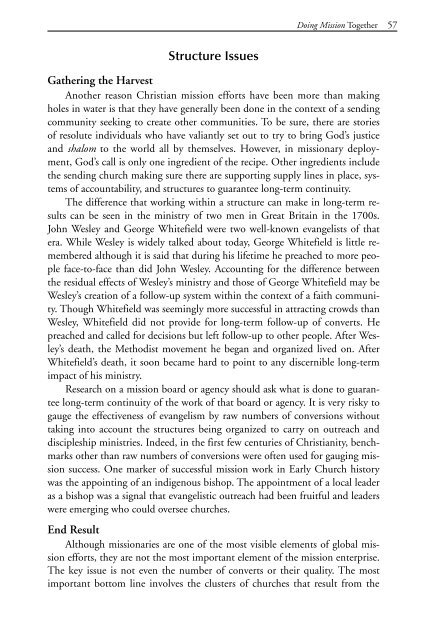discovering missions - Southern Nazarene University
discovering missions - Southern Nazarene University
discovering missions - Southern Nazarene University
Create successful ePaper yourself
Turn your PDF publications into a flip-book with our unique Google optimized e-Paper software.
245187 Disc Missions ins 9/6/07 1:04 PM Page 57<br />
Structure Issues<br />
Doing Mission Together 57<br />
Gathering the Harvest<br />
Another reason Christian mission efforts have been more than making<br />
holes in water is that they have generally been done in the context of a sending<br />
community seeking to create other communities. To be sure, there are stories<br />
of resolute individuals who have valiantly set out to try to bring God’s justice<br />
and shalom to the world all by themselves. However, in missionary deployment,<br />
God’s call is only one ingredient of the recipe. Other ingredients include<br />
the sending church making sure there are supporting supply lines in place, systems<br />
of accountability, and structures to guarantee long-term continuity.<br />
The difference that working within a structure can make in long-term results<br />
can be seen in the ministry of two men in Great Britain in the 1700s.<br />
John Wesley and George Whitefield were two well-known evangelists of that<br />
era. While Wesley is widely talked about today, George Whitefield is little remembered<br />
although it is said that during his lifetime he preached to more people<br />
face-to-face than did John Wesley. Accounting for the difference between<br />
the residual effects of Wesley’s ministry and those of George Whitefield may be<br />
Wesley’s creation of a follow-up system within the context of a faith community.<br />
Though Whitefield was seemingly more successful in attracting crowds than<br />
Wesley, Whitefield did not provide for long-term follow-up of converts. He<br />
preached and called for decisions but left follow-up to other people. After Wesley’s<br />
death, the Methodist movement he began and organized lived on. After<br />
Whitefield’s death, it soon became hard to point to any discernible long-term<br />
impact of his ministry.<br />
Research on a mission board or agency should ask what is done to guarantee<br />
long-term continuity of the work of that board or agency. It is very risky to<br />
gauge the effectiveness of evangelism by raw numbers of conversions without<br />
taking into account the structures being organized to carry on outreach and<br />
discipleship ministries. Indeed, in the first few centuries of Christianity, benchmarks<br />
other than raw numbers of conversions were often used for gauging mission<br />
success. One marker of successful mission work in Early Church history<br />
was the appointing of an indigenous bishop. The appointment of a local leader<br />
as a bishop was a signal that evangelistic outreach had been fruitful and leaders<br />
were emerging who could oversee churches.<br />
End Result<br />
Although missionaries are one of the most visible elements of global mission<br />
efforts, they are not the most important element of the mission enterprise.<br />
The key issue is not even the number of converts or their quality. The most<br />
important bottom line involves the clusters of churches that result from the

















